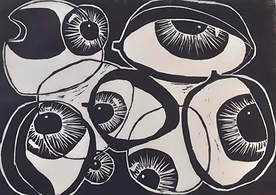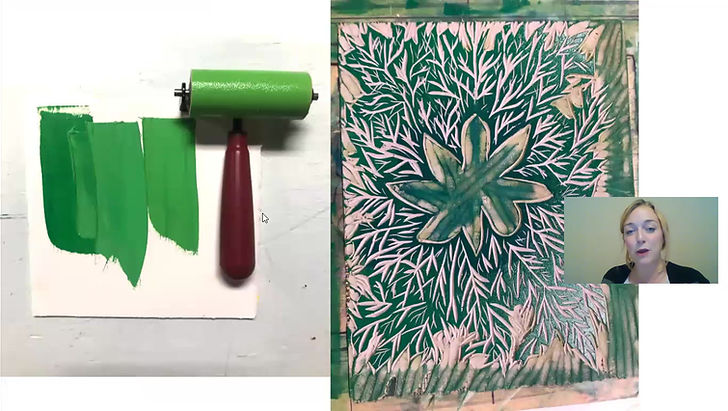VISION 2020: 11th Dayton/Kyoto Invitational Print Exchange & Exhibition

Micah Zavacky, Artist Talk
Exhibition
Clicking on an image will enlarge it and provide details about the work.

Interview with printmaker, Sherraid Scott
on the history of the Dayton / Kyoto print exchange

Sherraid Scott, EYES, woodblock, 2020

Sherraid Scott, EGNUS, woodblock, 2020
Why do you think artists are attracted to printmaking?
I really don’t know about other artists but for me I was attracted by the ability to make multiple copies of a piece and the chance to make changes on the original. I also enjoyed the different qualities that the various print making techniques offer: the fine line of etching, the broad flat color of silk screen, the chunky easy to do-at-home wood block prints and the grainy charcoal-like drawing of litho.
How did the Dayton-Kyoto print exchange begin and how long has it been going on?
I believe that Kim Vito has sent you a list of all the shows we have held and the titles of the themes. It started originally from my friendship with printmakers in Kyoto and the group at the Dayton Printmakers and wanting to have the two groups share their artwork. Yes, she was very helpful.
How is work chosen for the exhibition?
Any full-time member of the Dayton Coop may participate in the show. I assume this is also true for Kyoto.
Is there any theme for each exhibition and, if so, how is the theme decided?
The two groups alternate selection of the themes. I believe that we started with FACES and this last show, VISION 2020, was also a Dayton selection.
Are there any plans for a future Dayton/Kyoto print exchange?
The exchange has been a success so far and I hope it will continue in the future. All of us have been held up by the virus and so I am not sure when the next show will happen. Hopefully by 2022.
Sherraid Scott October 5, 2020
Interview by Janice Napier

Artist, Shannon Grecula shares her printmaking process
Printmaking Glossary
Printmaking Techniques:
Intaglio: Techniques that transfer ink from the recesses of a plate, rather than from the surface. Techniques using intaglio include etching, engraving, and drypoint. A variety of tools are used.
Lithography: A planographic technique that can print a variety of drawn and painterly marks, based on the principle that water and grease do not mix. The image is drawn or painted on the stone or metal plate with greasy litho crayon or greasy black ink.
Relief: Techniques using a printing block, plate or matrix that has had ink applied to raised areas on its surface that have been gouged away using a variety of tools.
Silkscreen Printing: A stenciling method that involves printing ink through stencils that are supported by a porous fabric mesh stretched across a frame called a screen to produce bold and graphic designs.
Printmaking Terms:
Acid: The corrosive solution used to etch a plate for intaglio printing. The concentration of this bath is precisely measured, as is the submersion time.
Chine-collé: The process of adhering one piece of paper to another by using a liquid adhesive and running them together through the printing press. Chine is French for “China,” which refers to the thin Asian paper originally used with this technique, and collé means “glued.”
Collagraph: A technique of relief printing using any combination of actual elements such as cardboard, fabric, washes, carborundum (an abrasive powder), or found objects, which are adhered to a plate, inked, and printed.
Drypoint: A technique of engraving, especially on copper, in which a sharp-pointed needle is used for producing furrows having a burr that is often retained in order to produce soft, velvety black lines. Aquatint: A technique of etching used to create tonal effects rather than lines. The resulting print often resembles watercolor.
Green Etching: Electrolytic process for etching metal plates without using acids.
Linocut: A relief technique using a sheet of linoleum, or similar material, from which shapes are gouged away using chisels or knives.
Matrix: A physical surface that can be manipulated to hold ink, which is then transferred to paper. Most, though not all, matrices are able to print the same image many times. Matrices used in printmaking include blocks of wood, sheets of linoleum, metal plates, sheets of Plexiglass, and slabs of limestone.
Relief Carving Tools: Tools, such as chisels and knives, used to carve into a matrix of wood or linoleum.
Ukiyo-e: The best-known type of Japanese woodblock art print. It often includes color and uses multiple blocks.
Woodblock printing (block printing): A technique for printing text, images or patterns used widely throughout East Asia. It originated in ancient China as a method of printing using multiple blocks on textiles and later paper.
Woodcut: The oldest form of printmaking, it is a relief process using knives and other tools to carve a design into the surface of a wooden block.
Wood engraving: A variety of woodcut which is printed using relatively lower pressure to produce more fine lines.
Compiled by Janice Napier
Information from the International Print Center New York https://www.ipcny.org/























